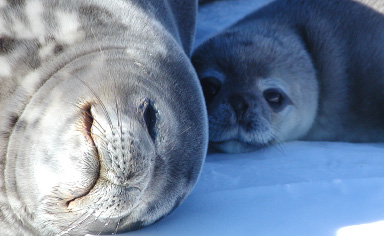|
Mike's work in diving physiology research is based in comparative physiology and understanding how the animal adapts to its environment. Marine mammals have tremendous breath holding capacity. (To prove this point when visiting high school classrooms, Mike asks for volunteers to hold their breath – for an hour and a half.)
Marine mammals can withstand hundreds of atmospheres of pressure – the world record for a seal is 2000 meters. They have no sinuses and thus no sinus problems, and they don't get the "bends". They have a soft chest and they fully exhale before diving, so that they are carrying no air in their lungs, and below 100 meters their lungs are totally collapsed. They carry the oxygen they need in blood and muscle, so no nitrogen gets into their blood. They can make dozens of dives in a day.
"These animals are exquisite yoga masters when it comes to control of blood flow." |


